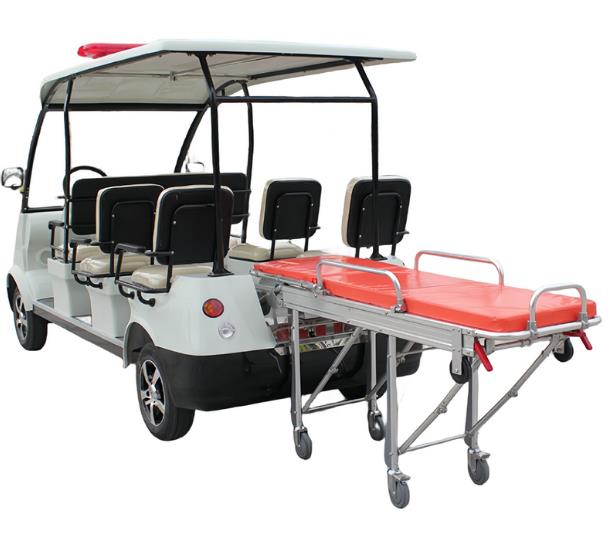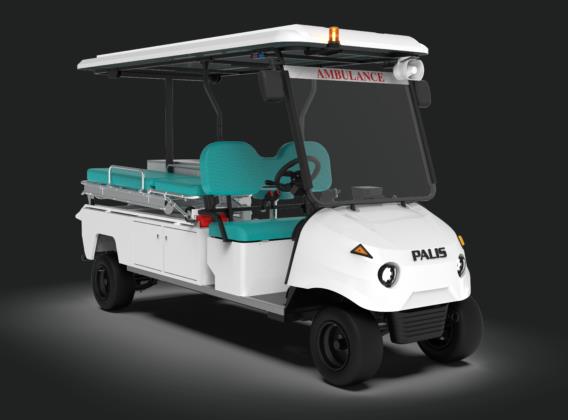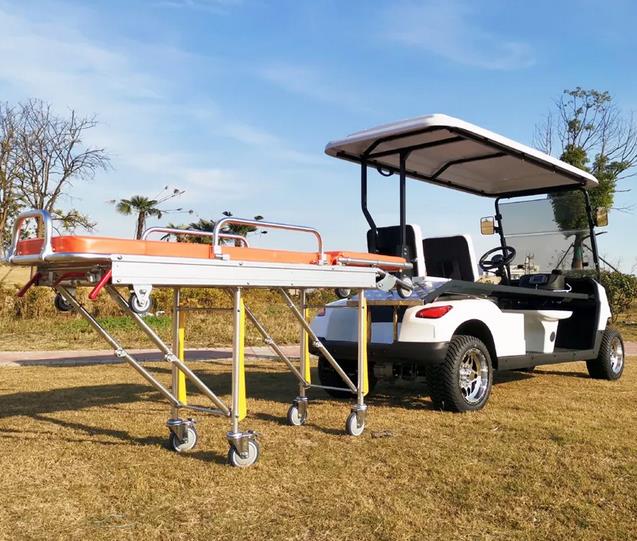Content Menu
● Introduction to Electric Ambulance Carts
>> Key Features of Electric Ambulance Carts
● Introduction to Motorized Stretchers
>> Key Features of Motorized Stretchers
● Efficiency Comparison in Emergency Situations
>> Electric Ambulance Carts
>> Motorized Stretchers
● Case Studies and Real-World Applications
>> Electric Ambulance Carts in Urban Settings
>> Motorized Stretchers in Hospital Settings
● Challenges and Future Developments
>> Electric Ambulance Carts
>> Motorized Stretchers
● Integration with Emerging Technologies
● Global Adoption Trends
● Conclusion
● FAQs
>> 1. What are the environmental benefits of electric ambulance carts?
>> 2. How do motorized stretchers reduce injuries among caregivers?
>> 3. What are the key features of advanced motorized stretchers?
>> 4. How do electric ambulance carts enhance emergency response times?
>> 5. What are the economic benefits of adopting motorized stretchers?
In recent years, the emergency medical services (EMS) sector has witnessed significant advancements in technology, particularly with the introduction of electric ambulance carts and motorized stretchers. Both innovations aim to enhance efficiency, reduce operational costs, and improve patient care during emergency situations. This article delves into the features, advantages, and efficiency of electric ambulance carts and motorized stretchers, comparing their roles in emergency medical services.

Introduction to Electric Ambulance Carts
Electric ambulance carts are designed to provide a sustainable, efficient, and environmentally friendly solution for emergency medical transportation. These carts are typically powered by electricity, reducing emissions and noise pollution compared to traditional fuel-based vehicles. They are equipped with advanced medical devices and offer quiet operation, which is beneficial in urban environments.
Key Features of Electric Ambulance Carts
- Zero Emissions: Electric ambulance carts produce no tailpipe emissions, contributing to cleaner air and reduced environmental impact.
- Low Noise: The quiet operation minimizes disturbance, especially in residential areas.
- Advanced Medical Equipment: They often include life support systems, diagnostic tools, and secure storage for medical supplies.
- Efficient Charging: Fast charging technology and battery swap options ensure continuous operation without downtime.
Introduction to Motorized Stretchers
Motorized stretchers are designed to reduce the physical strain on caregivers during patient transport. These stretchers use motorized systems to facilitate movement, lifting, and loading of patients, significantly reducing musculoskeletal injuries among paramedics and hospital staff.
Key Features of Motorized Stretchers
- Reduced Physical Strain: Motorized systems minimize manual pushing and lifting, reducing the risk of musculoskeletal disorders.
- Enhanced Maneuverability: Many models offer advanced mobility features, such as 360° turns and intuitive control panels.
- Cost Savings: By reducing injuries, motorized stretchers can lead to significant cost savings for healthcare organizations.
Efficiency Comparison in Emergency Situations
Electric Ambulance Carts
In emergency situations, electric ambulance carts offer several advantages:
- Rapid Response: They provide quick acceleration and can navigate through congested urban areas efficiently.
- Environmental Benefits: Zero emissions reduce air pollution, contributing to a healthier environment.
- Advanced Technology: Integration with GPS and real-time tracking systems helps responders reach patients faster.
Motorized Stretchers
Motorized stretchers enhance efficiency by:
- Reducing Injuries: Studies show a significant decrease in musculoskeletal disorders among caregivers.
- Streamlined Patient Transport: Automated lifting and loading reduce the time spent on patient transfer.
- Improved Caregiver Well-being: By minimizing physical strain, caregivers can focus more on patient care.

Case Studies and Real-World Applications
Electric Ambulance Carts in Urban Settings
In densely populated cities, electric ambulance carts have proven effective due to their quiet operation and ability to navigate through narrow streets. Their environmental benefits also align with urban sustainability goals. For instance, cities like Paris and Tokyo have implemented electric ambulance fleets to reduce emissions and improve air quality.
Motorized Stretchers in Hospital Settings
Hospitals have seen a significant reduction in caregiver injuries since adopting motorized stretchers. This technology has improved patient flow and reduced the economic burden associated with work-related injuries. A study conducted in a major metropolitan hospital reported a 60% decrease in stretcher-related injuries among staff after implementing motorized stretchers.
Challenges and Future Developments
Electric Ambulance Carts
- Charging Infrastructure: The widespread adoption of electric ambulance carts depends on the availability of charging stations. Governments and private companies are investing in expanding charging networks to support this transition.
- Range Anxiety: Concerns about battery life during extended operations remain a challenge. Advances in battery technology are addressing these concerns by increasing range and reducing charging times.
Motorized Stretchers
- Cost: The initial investment in motorized stretchers can be high, though long-term savings are significant. Many healthcare organizations are now considering the long-term benefits when budgeting for new equipment.
- Training: Staff may require training to effectively use these advanced systems. Manufacturers often provide comprehensive training programs to ensure seamless integration into existing workflows.
Integration with Emerging Technologies
Both electric ambulance carts and motorized stretchers are being integrated with emerging technologies such as AI, IoT, and telemedicine. For example, AI can be used to optimize route planning for electric ambulance carts, while IoT sensors can monitor the condition of patients being transported on motorized stretchers. Telemedicine capabilities allow for remote consultations during transport, enhancing patient care.
Global Adoption Trends
The adoption of electric ambulance carts and motorized stretchers varies globally. In Europe, there is a strong focus on electric vehicles due to stringent environmental regulations. In the U.S., motorized stretchers are widely used in hospitals to reduce caregiver injuries. In developing countries, both technologies are being introduced as part of broader healthcare infrastructure improvements.
Conclusion
Both electric ambulance carts and motorized stretchers offer unique advantages in emergency medical services. Electric ambulance carts provide rapid response times, environmental benefits, and advanced technology integration, while motorized stretchers reduce caregiver injuries and streamline patient transport. The choice between these technologies depends on specific operational needs and environmental considerations.

FAQs
1. What are the environmental benefits of electric ambulance carts?
Electric ambulance carts offer zero tailpipe emissions, reducing air pollution and contributing to a cleaner environment. This aligns with global efforts to combat climate change and improve public health.
2. How do motorized stretchers reduce injuries among caregivers?
Motorized stretchers minimize manual pushing and lifting, significantly reducing the risk of musculoskeletal disorders among paramedics and hospital staff. Studies have shown a reduction of up to 78% in stretcher-related injuries.
3. What are the key features of advanced motorized stretchers?
Advanced motorized stretchers often include features like hydraulic lifting systems, intuitive control panels, and 360° maneuverability. These features enhance caregiver safety and patient comfort during transport.
4. How do electric ambulance carts enhance emergency response times?
Electric ambulance carts provide rapid acceleration and can be equipped with GPS and real-time tracking systems. This enables responders to quickly locate and reach patients, improving response times in emergency situations.
5. What are the economic benefits of adopting motorized stretchers?
The economic benefits include reduced costs associated with caregiver injuries, such as medical expenses and lost workdays. Studies indicate that the initial investment in motorized stretchers can be recovered through these savings.










































